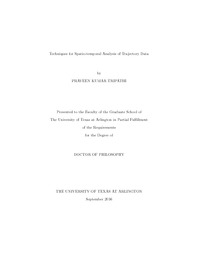
ATTENTION: The works hosted here are being migrated to a new repository that will consolidate resources, improve discoverability, and better show UTA's research impact on the global community. We will update authors as the migration progresses. Please see MavMatrix for more information.
Show simple item record
| dc.contributor.advisor | Elmasri, Ramez | |
| dc.creator | Tripathi, Praveen Kumar | |
| dc.date.accessioned | 2016-10-25T20:41:11Z | |
| dc.date.available | 2016-10-25T20:41:11Z | |
| dc.date.created | 2016-08 | |
| dc.date.issued | 2016-09-09 | |
| dc.date.submitted | August 2016 | |
| dc.identifier.uri | http://hdl.handle.net/10106/26171 | |
| dc.description.abstract | The goal of this thesis is to develop novel techniques for the analysis of spatio-temporal trajectory data. Recent advances in tracking devices such as Global Positioning System (GPS) and mobile phones have resulted in an abundance of spatio-temporal trajectory data. Because of the importance of both the space and time dimensions in trajectory data, different analysis techniques are needed. The analysis techniques explored in this thesis involve two variations: point based analysis and trajectory based analysis.
Point based analysis has been done to identify the hot spots in the trajectory dataset (hurricane data). Here we consider the trajectory data as a point data set. This analysis involves different combination of spatial, temporal and non-spatial attributes. We use density based clustering algorithms DBSCAN, to identify these hot spots. We extend DBSCAN algorithm to incorporate non-spatial attributes (wind speed and time) with spatial attributes. This approach has also been used to identify the starting regions and the landing regions of hurricanes.
In the trajectory based analysis, we focus on trajectory simplification (smoothing), outlier filtration and directional analysis. Our smoothing method is based on internal angles of trajectories. Some trajectory data sets are noisy in nature; therefore we need some pre-processing to remove the noise. In the pre-processing stage, we smooth the trajectories to remove some trajectory points to obtain smooth and directionally consistent trajectories. We propose methods for smoothing the trajectories considering the directional attribute. We propose a framework for the directional analysis of the trajectory data to obtain the directional patterns.
The framework involves segmentation of the smooth trajectories into directionally consistent categories of sub-trajectories. We identify 16 directional categories for this task. After this stage of the framework, we perform outlier filtration using a novel convex hull based approach. The outlier filtration stage is followed by a clustering algorithm on these sub-trajectories to obtain the directional patterns. For the evaluation of the proposed framework we used two real datasets: a hurricane data set and an animal movement data set. | |
| dc.format.mimetype | application/pdf | |
| dc.language.iso | en_US | |
| dc.subject | Spatio-temporal | |
| dc.subject | Trajectory | |
| dc.subject | Clustering | |
| dc.subject | Analysis | |
| dc.title | Techniques for Spatio-temporal Analysis of Trajectory Data | |
| dc.type | Thesis | |
| dc.degree.department | Computer Science and Engineering | |
| dc.degree.name | Doctor of Philosophy in Computer Science | |
| dc.date.updated | 2016-10-25T20:42:14Z | |
| thesis.degree.department | Computer Science and Engineering | |
| thesis.degree.grantor | The University of Texas at Arlington | |
| thesis.degree.level | Doctoral | |
| thesis.degree.name | Doctor of Philosophy in Computer Science | |
| dc.type.material | text | |
| dc.creator.orcid | 0000-0003-1695-467X | |
Files in this item
- Name:
- TRIPATHI-DISSERTATION-2016.pdf
- Size:
- 13.32Mb
- Format:
- PDF
This item appears in the following Collection(s)
Show simple item record


